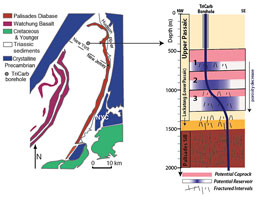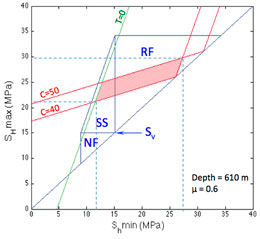Natalia V. Zakharova and David S. Goldberg
Induced seismicity due to pore pressure increase presents a significant risk for carbon sequestration in fractured formations. In order to evaluate fracture stability, detailed knowledge of the in situ stress is required. High-resolution wellbore images allow identifying both natural discontinuities and drilling-induced failures indicative of the in situ stress regime. This study demonstrates an application of borehole techniques for stress analysis at a potential CO2-storage site in the Newark Rift basin in the northeastern U.S (TriCarb project). Effects of borehole deviation on wellbore failure and constraints on complete stress field have been determined. Stability of natural fractures at various depths was evaluated for a range of potential stress profiles. Preliminary analysis suggests that a significant capacity for pore pressure increase without fracture reactivation exists in deeper reservoirs, but additional in situ test data are needed for a more complete assessment of the induced seismic risk from potential CO2 injection in the region.

Study site location, and a schematic diagram of the TriCarb borehole indicating three potential reservoir-caprock pairs in the Passaic formation of the Newark Basin supergroup.

Magnitudes of horizontal stresses at the top of reservoir layer 1 based on Coulomb faulting theory and Anderson’s classification of faults. Permissible stress ranges highlighted in red correspond to the case of breakouts occurrence in layers with rock strength C=40-50 MPa, and an absence of tensile fractures. (The red lines outline the stress conditions for borehole breakouts formation, the green line corresponds to the criterion for occurrence of drilling induced tensile fractures for zero tensile strength. The blue polygon indicates limits of Mohr–Coulomb failure for frictional equilibrium of pre-existing faults. Three regions separated by the blue lines correspond to normal faulting (NF), strike-slip faulting (SS) and reverse faulting (RF) stress conditions.)
Related links:
Drilling for Carbon-Storing Rocks in Suburban New York
Lamont projects on induced seismicity from underground injections
Geomechanical Software Used in the Project
Select Publications:
Zakharova, N. V., D. S. Goldberg, and D. Collins (2013), In-Situ Stress Constraints from Borehole Data in the Context of CO2-Storage Site Characterization, Proceedings of the 47th US Rock Mechanics/Geomechanics Symposium, 23-26 June 2013, San Francisco, California, USA.
Goldberg, D. S., T. Lupo, M. Caputi, C. Barton, and L. Seeber (2003), Stress regimes in the Newark basin rift: evidence from core and downhole data, The great rift valleys of Pangea in eastern North America, 1, 104-117.
